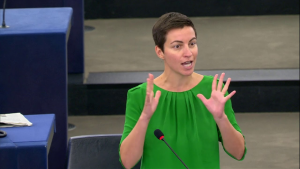The leaders of Europe met in the Romanian town of Sibiu this week and agreed on ten points regarding the future of Europe.
Climate change featured only tenth as a priority though.
Reacting to the outcome the co-leading candidate of the European Green Party, Greens/EFA co-president Ska Keller was very critical of this.

She said:“The seriousness of the threat of climate change still clearly hasn’t registered for the European leaders meeting in Sibiu today. Climate change features merely as an afterthought demonstrating that the urgent pleas from the younger generation have fallen on deaf ears.”
“They pledge to be responsible global leaders, but are instead showing a complete dereliction of duty with regard to the future of our planet. We extend our full solidarity to the students of #FridaysForFuture to make climate a priority and set binding targets for Europe to meet the climate crisis.
The co-leading candidate of the European Green Party, Dutch MEP Bas Eickhout said: “The scientific community have been categoric: there can be no future without climate action.”

“This declaration is not fit for purpose and an insult to the young people who are calling on political leaders to take concrete climate action. It misses a golden opportunity to get serious about setting binding targets for Europe to be carbon neutral before 2050. The clock is ticking but the young and old marching for climate today give us hope that eventually the message will start to get through.”
NATO AWACS surveillance aircraft, meanwhile, helped guard the airspace over the European Union Summit in Sibiu. NATO AWACS routinely patrol the skies during major events, including meetings of world leaders and other high-profile public events, such as international football tournaments.
“NATO AWACS provides an important capability and we are proud to deliver support to this event”, said United States Air Force Brigadier Gen Andrew Hansen , Deputy Chief of Staff Operations at Allied Air Command, Ramstein. “This shows the close cooperation between NATO and the European Union”.
The mission came at the request of the Romanian government.
NATO has fourteen E-3A AWACS aircraft, which are modified Boeing 707s, easily identifiable from the distinctive radar dome mounted on the fuselage. The E-3A usually operates at an altitude of around 10 km. From this altitude a single E-3A can constantly monitor the airspace within a radius of more than 400 km and can exchange information – via digital data links – with ground-based, sea-based and airborne commanders. An E-3A flying within NATO airspace can distinguish between targets and ground reflections and is therefore able to give early warning of any low- or high-flying aircraft operating over the territory of a potential aggressor.




